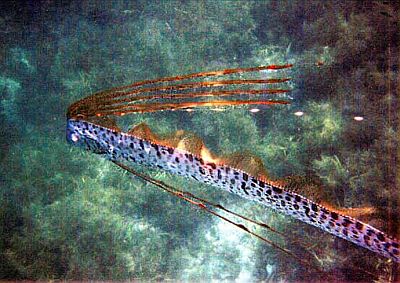Can deep sea fish feel the signs of an earthquake?

by Udo Schröter
Although there is a lot of theories that it can be seen on the Internet before the occurrence of a major earthquake, such as Ryugunotukai and megamouse, which are said to be phantom fishes, it is statistical that there is actually a link between deepwater fish and earthquakes Research has not been done much. Japanese researchers who thought that 'if there is a link between the two, can we reduce the earthquake damage?' Investigate the discovery report of a large earthquake and deepwater fish that occurred between 1928 and 2011. And the results are published in scientific journals.
Deep sea fish appearance report confirmed in Japan from 1928 to 2011
(PDF file) http://www.scc.u-tokai.ac.jp/iord/bulletin/files_for_bulletin/KENPOU39_37-79_Orihara.pdf
Deep-Sea Fish Do Not Signal Upcoming Earthquake in Japan | Seismic Society of America
https://www.seismosoc.org/news/deep-sea-fish-do-not-signal-upcoming-earthquake-in-japan/
Are deep sea fish appearing in shallow waters and shores not signs of earthquakes or tsunamis? The idea of having existed for a long time, and in the case of the Great East Japan Earthquake in 2011, there were reports that more than a dozen long-eared sea lions were launched along the coast in a year, and such an opinion has recently been made on the Internet in recent years There are also many websites to claim.
Most recently, it was a topic on January 31, 2019, when the Uozu Aquarium in Toyama Prefecture published a photo of Ryugu Notsukai , which was caught on a fishermen's net. Long-eared sea bream is originally a fish that inhabits 200 to 1000 meters of water depth and does not originally come to the sea level, but it is said that the individual in the picture was the seventh animal raised in the same area during one season.
A study of Yoshiaki Orihara and others belonging to Tokai University, who investigated the relationship between such 'deep sea fish' and 'earthquake' on June 18, 2019, was published in the Journal of the American Seismological Society.
This study investigated whether an earthquake occurred within 50 km or 100 km from the place where deep sea fish appeared in the period from November 1928 to March 2011, and within 30 days thereafter. Because 'precursor actions' in which animals take unusual behavior before an earthquake occurs have been reported so far, researchers have targeted earthquakes with a magnitude of 6 or greater.
Originally Professor Obihara heard that deep sea fish had been witnessed in large numbers before the Great East Japan Earthquake, and started the investigation, 'If this is true, there is a possibility that earthquake damage can be mitigated.' There have been studies that have examined the emergence of deep-sea fish in the past, but because the statistical amount was insufficient for reporting, it seems that researchers started by collecting regional papers that report the emergence of deep-sea fish.
During the study period, 336 records of deep sea fish were observed and the number of earthquakes was 221, but only 1 was considered to be correlated. It was found that deep sea fish were never reported before the occurrence of a magnitude 7 earthquake, and that no evidence of deep sea fish was reported by 10 days before the occurrence of a magnitude 6 earthquake or more. .
According to the results of this study, Mr. Orihara said that 'There is almost no relation between deep sea fish and earthquakes in Japan since 2000,' 'In fact, many appeared on the Japan Sea side in the winter of 2009, but what There was no need to worry about this again . '
The overseas news media CNN also published an article on the relationship between 'deep sea fish' and 'earthquake' in February 2019. At this time, coverage was held at the Uozu Aquarium.
Sightings of rare oarfish in Japan raise fears of earthquake and tsunami-CNN
https://edition.cnn.com/2019/02/01/asia/oarfish-sighting-tsunami-earthquake-fear/index.html
Mr. Nishima Kazusa of the Uozu Aquarium told CNN, 'There is no scientific evidence that Ryugunotukai will appear before a big earthquake, but there is no denying 100% of the possibility,' while 'global warming There may be some reasons why we are affecting Ryugu Notsukai or why we are not aware of it, ”commented.
In addition, about Ryuugunotukai that was witnessed a lot before the Great East Japan Earthquake, Mr. Nishima may have pushed Ryugunotukai from the ocean floor to the surface as a result of changes in the ocean current caused by slight crustal movements occurring on the ocean floor before the earthquake. I commented that it was not. On the other hand, Mr. Osamu Inamura, director of the Uozu Aquarium, explained that 'Ryugounotsukai has something to eat such as shrimp, but when it goes after plankton, Ryugunotsukai also faces the sea surface,' Can get caught in the net. ”
Related Posts:







